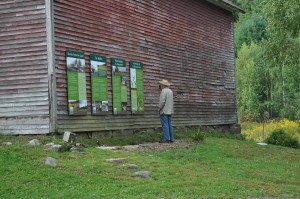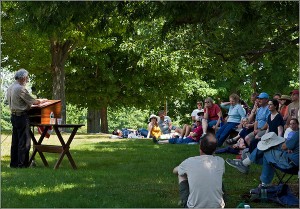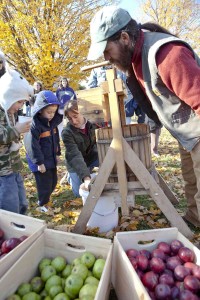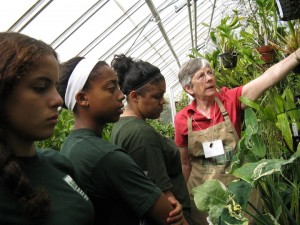Planning for engagement
11 May 2012 – Kate Preissler

For some people, being able to reflect on information in a solitary way is as effective a way to learn as something more interactive.
In the two years that I have worked in my current position as Western Region Engagement Manager with The Trustees of Reservations, I get asked one question more than any other: “What is an Engagement Manager?”
Although I have a short response–“I oversee any point of contact between our properties and the public”–the frequency with which I encounter the question motivates me again and again to contemplate the work of “engagement” and what it really means to “manage” it at our sites.

For others, the power of poetry, read aloud at a beautiful place like Bryant Homestead on a beautiful day, forges a connection between the past and the present.
I have heard “engagement” used as a synonym for “education” or “interactivity” but I’ve found that it encompasses more than those two strategies. The more I learn, the more I like the term. I’m a fan of the concept of engagement for two primary reasons:
- Engagement puts people at the center rather than collections. For me, successful engagement has more to do with how the person has been changed by a place (or story) and less to do with the place itself.
- Engagement acknowledges that people connect with properties (and stories) in many different ways–exhibits, tours, educational programs, physical artifacts, volunteer projects, work experiences, landscape vistas, internships, media coverage–and that it is important to value and utilize different techniques in order to reach all kinds of people .

Small children have a tougher time with panels and poetry, but engaging all of their senses with the tastes and smells of apple cider making provides them with a new experience and memory to take with them.
People relate to place in personal ways. Some learning styles are attracted to certain types of engagement and shy of others. Generational affiliation, cultural background, lifestyle, education level–all of these things impact the way we experience place and how we connect to the past. So a big challenge of managing engagement becomes: how can I facilitate engagement with so many invisible factors?
One method I use is to ask a set of questions for each site. The answers help me clarify what engagement strategies we should pursue and how we will determine our success year to year. Some of the questions I ask are:
- To what end am I trying to engage people? My engagement goals cover the spectrum from being aimed at promoting a very specific action amongst participants (for instance voting in support of CPA laws to broad goals like making sure they have an enjoyable time on our property. The strategies that I would employ to achieve the former are very different than what I would use for the latter. There are so many great reasons to engage audiences, but it’s important to ask yourself “why” at the outset and then stay consistent to your answer when designing engagement opportunities.
- Who am I most interested in engaging? We want everyone and anyone to visit our properties and to value them, but it is easier to build a strong engagement component and to understand your success if you have clearly articulated target audiences in mind. An audience can be broad or specific. My target audiences range from categories like “residents of Stockbridge” to “college students” to “teenagers in Holyoke.”
- Is depth of engagement or reaching a large number of people more important to this goal? Although it is not always true that you have to decide between depth and breadth, in my work it tends to be the case. I can work for several months one-on-one with a graduate student intern on major projects, deepen their understanding of our mission, enhance their skill set and point them towards a career working towards the same mission. I can also spend 5 minutes on a local news show talking about the importance of winterizing your old homes and have that message presented to thousands of people. I can do all sorts of things in between, all of which are valid, valuable forms of engagement that may be the most strategic choice depending on my goals.
- Is there a need that I can fill with my engagement? The best way to make a place relevant to and valued by a community is for it to have a clear role. When I am choosing strategies, I take into account what forms of engagement might support other aspects of the quality of life of my audience. Providing internships when colleges are nearby, teen jobs where there aren’t many, activities for families with young kids, or a place to walk dogs in a dense area are all examples of how our sites can support community needs. This might seem obvious, but the best way to find out what a community’s needs are is to ask the community.
I try to revisit these questions before each season to see if any of our answers have changed. Often our resources, priorities, or something in the community will have shifted since we first looked at them.

The small group format of our Youth Conservation Corps means the teens get involved in conversations rather than sit through lectures, they have their senses and their minds engaged, and they get to be a part of our work team – all strategies that came from us thinking carefully about our audience.
At the end of your project or season, as you are sitting in front of the pile of data that you have tracked (You do track your data right? You must track your data!), these same questions can then be flipped around to help you start to measure your success. For instance, number 2 can be flipped to form a very clear success measure: What percentage of my participants came from my target audience? The others may involve developing some more complex tools to measure results, but by understanding what you’ll want to know at the end before you start, you can set yourself up to collect the data you will really need.
At the end of it all, having clear goals about why and how I want to engage people allows me to feel our successes more deeply. I can point to specific outcomes and say – we had a positive impact!
Are there any particular questions that you ask yourself when planning for engagement at your museum or site? Are there any questions that you wished you had asked before venturing into a new project?
~ Kate Preissler is the Western Region Engagement Manager for The Trustees of Reservations, coordinating points of contact between the public and about 40 historic, ecological, and recreational sites in the Berkshires, Pioneer Valley, and Central Massachusetts. The Trustees is a private organization whose mission is to permanently preserve properties of exceptional scenic, historic and ecological value in Massachusetts for public use and enjoyment. Kate holds a B.A. from Bates College in English and History and graduated from the UMass Amherst Public History Masters Program in 2010.




What a fascinatingly diverse group of people you get to engage with! How much of that diversity, do you think, comes from the fact that your sites mix “outside” and “inside” elements? Do you consider intergenerational engagement to be a goal, and if so, what are your favorite strategies fro achieving it?
Adina, I think the diversity of audiences has more to do with the spectrum of sites I work with (for example, Stockbridge, MA is more affluent, touristy, and has an identity around arts and culture while Holyoke, MA is a struggling old mill town with a strong community interest in health, recreation, and quality of life) It’s a pretty large geography to work across, and one of the challenges for me is that no single strategy works for all the different communities. If I just took one site as an example (and maybe I’ll do that in a future post!), it would be a very different story. That’s one of the big reasons I need questions like the ones above to help me develop custom-designed strategies for each site.
I have not done a lot with intergenerational engagement although it’s definitely in my mind. As the generation gap between visitors at our historic home properties and recreational properties becomes more pronounced, it’s hard not to think about the opportunities. I, too, would be interested to hear from those who have some suggestions!